| Kingtronics | B.I.(Beckman) | Bourns | Murata | Vishay | Tocos |
| RKT-3362P | 25P | 3362P | PVC6A | CT-6P/ FT-6P/T73YP/76P | GF063P |
| RKT-3329P | 62M,82M | 3329P | PV32P | RJ-6P/T7YA/75P | RJC06P |
| RKT-3329H | 82P | 3329H | PV32H | RJ-6W/T7YB/T7YB/75H | RJC06W |
| RKT-3006P | 89P | 3006P | PV23P | CT-20P/T18/43P | RJC097P |
| RKT-3386P | 72P | 3386P | PV34P | T20YP/63P | |
| RKT-3296W | 67W | 3296W | PV36W | CT-94W/CT-9W/T93YA/64W | J9W |
| RKT-3296X | 67X | 3296X | PV36X | CT-94X/CT-9X/T93XA/64X | J9X |
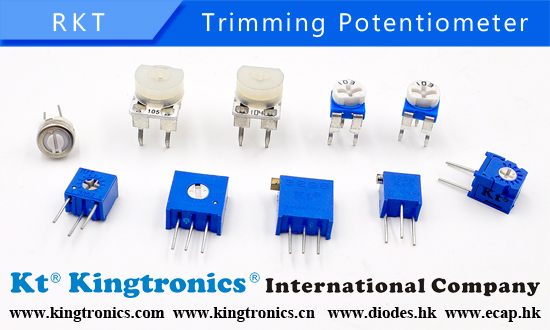
Kt Kingtronics Offer Electrode Surge Arresters
22 Oct 2010Kingtronics sales had sucessful exhibition at HK fair, our blue nice booth might leave you deeply impression, right? Please visit our blog to see our photos at HK fair: www.kingtronics.cn.
Do you buy 3-Electrode Surge Arresters and 2-Electrode Surge Arresters . Kingtronics produce Surge Arrester in our factory, lead time is short, prices are as competitive as our diode rectifier M7, everybody know Kingtronics rectifier M7, hehe.. More important, this products we don't have much competitors. Please send us inquiry for diode and surge arresters.
Our surge arresters can cross to Nisshin Electric and Epcos:
- SR3YP Series(ITU-T Standard): 3-Electrode Arresters
- SRYH Series(ITU-T Standard): 2-Electrode Arresters
BTW, our website www.kingtronics.com is updated, you can download part list of diode, cross reference of capacitors, Trimming Potentiometer, and SGS certifications from our website.
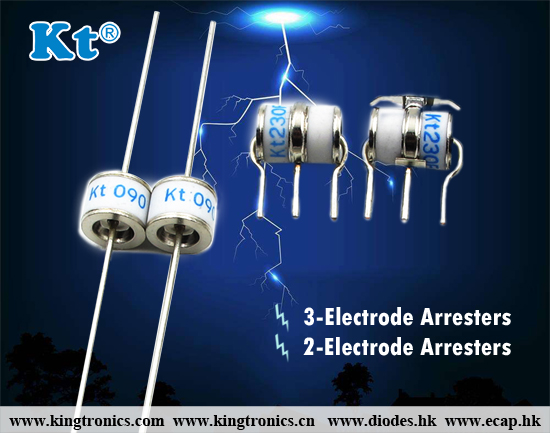
The largest application for tantalum is in the electronics capacitor industry, totaling approximately 68 percent of global demand, as its high melting point, strength, ductility, reliability, resistance to corrosion and thermal conductivity make the metal an efficient, reliable and environmentally versatile component for capacitors. These tantalum capacitors are commonly found in such products as wireless devices, LCD monitors, DVD players, cell phones, personal computers, digital cameras, gaming platforms, telephone switch boards and computer networks because of unequaled capacity to store and release electrical charges.
Now, Kingtronics lead time are better than AVX, Kemet, Vishay...Welcome to send us inquiry!
CKT: http://www.kingtronics.com/tantalum-capacitors/chip-tantalum-capacitors.html
TKT: http://www.kingtronics.com/tantalum-capacitors/dipped-tantalum.html
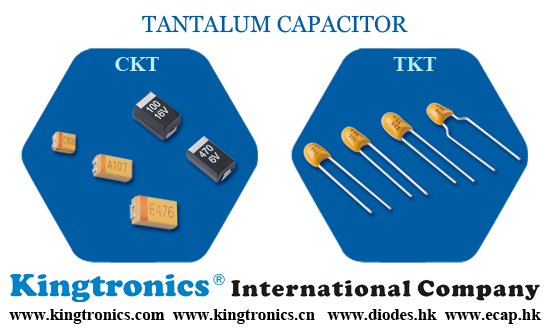
Multilayer Ceramic Capacitor(MLCC) is an electronic part that temporarily stores an electrinical charge and the most prevalent type of capacitor today.New technologies have enabled the MLCC manufacturers to follow the trend dictated by smaller and smaller electronic devices such as Cellular telephone,Computers,DSC,DVC,GPS.
Besides chip mlcc capacitor, Kingtronics radial mlcc capacitor (mono capacitor) is unbeatable in the market - Good price, High quality and Short lead time.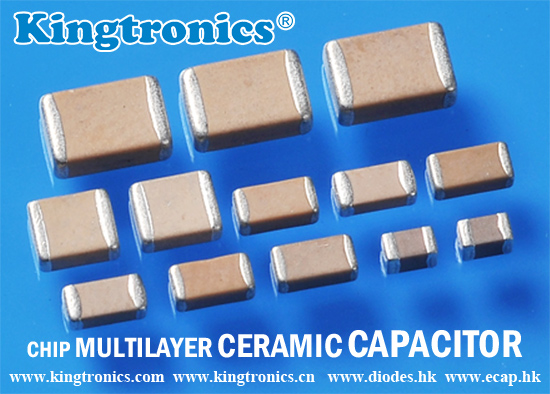
From Oct 13th - 16th, Kingtronics had successful exhibition in HK ElectronicsAsia2010. We met many old customers and new customers.
Our tantalum capacitors,Trimming Potentiometer and diode rectifier have very good feedback.
Learn more:http://www.kingtronics.com/


Kt Kingtronics MLCC and Ceramic Casting Films
16 Oct 2010Mitsubishi Polyester Film offers a complete portfolio of film products to support the worldwide Mono Capacitors and ceramic casting markets. Hostaphan® polyester film is approved for use in high end ceramic applications as a release liner. Hostaphan® film is the leading choice of polyester film for ceramic casting world wide. The Hostaphan® product delivers the following superior product attributes:
- Extremely smooth surface
- Optimized shrinkage
- Superior handling characteristics
- Chemical resistance
- Excellent flatness
- Ultra thin, highly cured coatings
- Controlled static levels
- Manufactured in a clean environment
Mitsubishi Polyester Film products are typically used in electronics applications. Hostaphan® polyester film product categories for ceramic casting film are as follows:
- Ceramic substrates
- Solvent based multilayer ceramic capacitors (MLCC)
- Water based multilayer ceramic capacitors (MLCC)
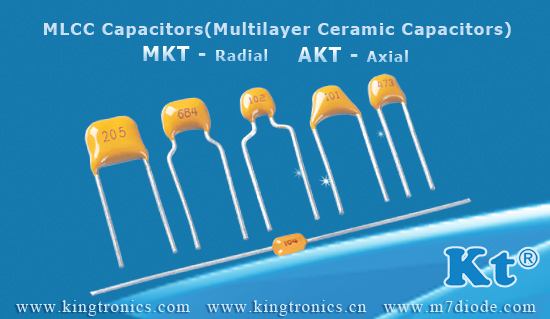
Imagine a perfectly innocent quartz crystal that has grown to considerable size. It is lying there, at the bottom of a shallow sea, when a meterorite rudely invites itself to crash into the Earth's surface with considerable noise, pressure, heat.
There is so much pressure and heat, in fact, that only a meteorite or asteroid can cause what happens next: the quartz is shocked!
Shocked quartz is quartz that has been subjected to an event that cannot happen from normal Earthly causes and which has had its very planar structure changed. The only two known causes of shocked quartz are nuclear explosions such as the Alamo field and the incredible impact forces of meteorites or ancient asteroids. The Pleistocene/Holcene astroid impact is one of the biggest culprits. This impact occured in North America about 12,000 years ago, creating a type of brecciated rock called impact breccia.
One aspect of the impact that creates shocked quartz, however, is that high heat is not involved, or the quartz would revert to its original structure. In some shocked quartz samples, the quartz resumed its normal growth pattern within a section of planar deformities.
Brecciated rock is like gravel that is cemented together in a finely grained matrix that may or may not have the same composition as the gravel. Impact breccia is formed through extra terrestial or nuclear impact and is generally found in or around impact craters.
Quartz crystals are said to be the second most abundant substance in the Earth's crust. They are composed of silicon-oxygen tetrahedra where one oxygen molecule is shared between each two tetrahedron. The crystals grow perpetually in a six sided prism that terminates in a six sided pyramid.
Shocked quartz crystals contained shocked lamellae, or small fractures that create lines in the quartz that go along the planes of the crystal. These planes can usually only be viewed under a microscope. \
But often, special microscope techniques, such as electron microscope, high resolution transmission electron microscopy (TEM), Focused Ion Beam (FIB) tomography, cross polarization, reflected light, thin slicing and polishing are required before the microscopic deformations can be seen.
Sometimes, the deformations actually can be examined as if they were "pressure gauges", with various deformities helping to identify the amount of pressure that it would have taken to create them. New methods of examining the samples are being used, with goals of gathering more information and images of smaller and younger samples.
The most famous sites for such impact craters include the Chicxulub structure on the Northern Yucatan Penninsula of Mexico, the Bavarian Town of NÖrdlingen, Arizona, India, and generally in the K-3 boundary between Cretaceous and Tertiary rocks.
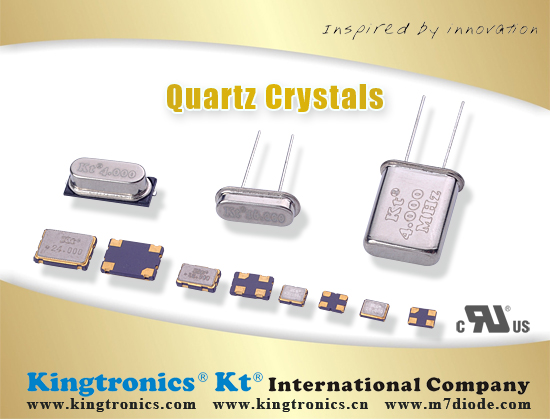
Diodes has announced the first device from a proprietary semiconductor process at its wafer fabrication facility in Oldham.
The device is a high efficiency 600V, 8A rectifier targeted at LCD-LED TV power supplies.
Called Diodestar, the process combines bipolar and mosfet semiconductor technologies in a high voltage process.
The first product fabbed on the new process is the DSR8V600, a 600V 8A rated rectifier, tailored for use as the boost diode in the power factor correction (PFC) circuits of single and dual stage switched mode power supplies (SMPS) up to 1,000W.
optimised for PFC duties in continuous and boundary conduction mode, this family of rectifiers will offer best in class soft recovery with ultra fast switching capability (TRR<30ns), meeting the requirements of the 80 Plus Energy Star standard for SMPS.
Kt Kingtronics Showa Denko to Expand Production Capacity for Titanium Oxide Nanoparticles
16 Oct 2010Tokyo, Oct 13, 2010 (JCN Newswire via COMTEX) -- Showa Denko K.K. (SDK) will expand nanoparticle titanium-oxide production capacity at its fully-owned subsidiary Showa Titanium Co., Ltd., from 180 tons a month at present to 240 tons a month as from June 2011. The product, sold under the trade name of Super-Titania(TM), is used in the production of multilayer ceramic capacitors (MLCC Capacitors).
MLCC Capacitors are used mainly in electronic devices that require small size and light weight, such as PCs and mobile phones, as well as in such digital electric appliances as flat-panel TVs. Reflecting increasing demand for these products, the MLCC market is expected to continue growing at around 10% a year.
Under the circumstances, Showa Titanium will enhance the efficiency of production facilities for Super-Titania for MLCC applications and increase the number of production lines from three to four.
Titanium oxide (TiO2) is used in the production of barium titanate (BaTiO3), which is then used as raw material for dielectric*, one of the basic components of MLCC Capacitors. Furthermore, to produce small and high-capacity MLCC Capacitors, it is necessary to obtain high-purity, fine-particle BaTiO3. While there are two different processes for the production of BaTiO3 (solid-phase and liquid-phase**), fine-particle TiO2 is required for the solid-phase process, which enables low-cost production of BaTiO3 with superior dielectric properties. As Showa Titanium uses the most advanced process control technology, the company can provide Super-Titania in ultra-fine particle sizes, ranging from 15 to 250 nm (1 nm:one-millionth of mm). The product also has high purity, ensuring the production of MLCC Capacitors with smaller size and higher capacity.
In addition to the MLCC application, Super-Titania is used in various fillers and photocatalysts. To meet diversified needs of customers, we will provide high-quality products in a stable manner, establishing our leading position on the market.
* Dielectric: A material which is an electrical insulator, having the capability to store electricity and to discharge electricity instantly. As its dielectric properties improve, dielectric comes to have higher capacity to store electricity.
** Solid-phase and liquid-phase: Processes for the production of fine ceramics, including BaTiO3. In the solid-phase process, materials are mixed, and baked at high temperatures, resulting in synthesis of compounds through chemical reactions. In the liquid-phase process, materials are dissolved in a solution and undergo chemical reactions. Then the materials are baked at low temperatures, and converted into compounds.
Contact us
Tel: (86) 769 8118 8110
Tel: (852) 8106 7033
Fax: (852) 8106 7099
E-mail: info@kingtronics.com
Skype: kingtronics.sales
MSN: kingtronics-sales@hotmail.com
Web: www.Kingtronics.com
YouTube: www.youtube.com/c/Kingtronicskt
About
Kingtronics International Company was established in 1995 located in Dongguan City of China to handle all sales & marketing for factories located in Chengdu, Sichuan and Zhaoqing, Guangdong, China. In 1990, we established the first factory to produce trimming potentiometer and in 1999 we built up new factory in Zhao Qing, Guangdong. Now with around 850 workers, Kingtronics produce trimming potentiometers, dipped tantalum capacitors, multilayer ceramic capacitors, and diode & bridge rectifier. We sell good quality under our brand Kingtronics, and Kt, King, Kingtronics are our three trademarks. All our products are RoHS compliant, and our bridge rectifier have UL approval. Please visit our Products page, you could please download all our PDF datasheet and find cross reference for our Trimming Potentiometer and capacitors.
Tantalum and Ceramic Capacitors Cross Reference ↓ Download
Diodes & Rectifiers List(PDF: 97KB) ↓ Download
Trimming Potentiometer Cross Reference ↓Download
Categories
- Kt Kingtronics (245)
- Diodes & Rectifiers (159)
- Aluminum Electrolytic Capacitor (149)
- Trimming Potentiometers (123)
- Tantalum Capacitors (94)
- Multilayer Ceramic Capacitors (70)
- Kt Bridge Rectifier (64)
- Quartz Crystals (58)
- Surge Arresters (34)
- Tactile Switches (32)
- Kt Kingtronics Components (30)
- Ceramic Trimmer Capacitors (25)
- Film Capacitors (23)
- Super Capacitors (17)
- Metal Oxide Varistor (10)
- Negative Temperature Coefficient Thermistor (6)
- Music capacitors (2)
Archives
- 2024 April (2)
- 2024 March (2)
- 2024 February (2)
- 2024 January (3)
- 2023 December (1)
- 2023 November (2)
- 2023 October (1)
- 2023 September (2)
- 2023 August (2)
- 2023 July (4)
- 2023 June (12)
- 2023 May (6)
- 2023 April (4)
- 2023 March (3)
- 2023 February (2)
- 2023 January (1)
- 2022 December (3)
- 2022 November (2)
- 2022 October (3)
- 2022 September (4)
- 2022 August (3)
- 2022 July (3)
- 2022 June (2)
- 2022 May (3)
- 2022 April (4)
- 2022 March (4)
- 2022 February (2)
- 2022 January (3)
- 2021 December (4)
- 2021 November (3)
- 2021 October (4)
- 2021 September (4)
- 2021 August (4)
- 2021 July (4)
- 2021 June (5)
- 2021 May (4)
- 2021 April (3)
- 2021 March (4)
- 2021 February (4)
- 2021 January (4)
- 2020 December (5)
- 2020 November (4)
- 2020 October (4)
- 2020 September (7)
- 2020 August (8)
- 2020 July (9)
- 2020 June (8)
- 2020 May (9)
- 2020 April (11)
- 2020 March (6)
- 2020 February (4)
- 2020 January (4)
- 2019 December (6)
- 2019 November (7)
- 2019 October (6)
- 2019 September (5)
- 2019 August (9)
- 2019 July (6)
- 2019 June (4)
- 2019 May (16)
- 2019 April (6)
- 2019 March (6)
- 2019 February (9)
- 2019 January (5)
- 2018 December (4)
- 2018 November (4)
- 2018 October (5)
- 2018 September (8)
- 2018 August (10)
- 2018 July (7)
- 2018 June (12)
- 2018 May (22)
- 2018 April (4)
- 2018 March (4)
- 2018 February (8)
- 2018 January (13)
- 2017 December (4)
- 2017 November (4)
- 2017 October (5)
- 2017 September (4)
- 2017 August (21)
- 2017 July (7)
- 2017 June (5)
- 2017 May (4)
- 2017 April (4)
- 2017 March (9)
- 2017 February (8)
- 2017 January (8)
- 2016 December (10)
- 2016 November (16)
- 2016 October (8)
- 2016 September (10)
- 2016 August (13)
- 2016 July (12)
- 2016 June (10)
- 2016 May (14)
- 2016 April (8)
- 2016 March (10)
- 2016 February (6)
- 2016 January (8)
- 2015 December (10)
- 2015 November (8)
- 2015 October (3)
- 2015 July (5)
- 2015 June (9)
- 2015 May (7)
- 2015 April (8)
- 2015 March (9)
- 2015 February (7)
- 2015 January (5)
- 2014 December (13)
- 2014 November (4)
- 2014 October (4)
- 2014 September (5)
- 2014 August (4)
- 2014 July (4)
- 2014 June (4)
- 2014 May (4)
- 2014 April (4)
- 2014 March (5)
- 2014 February (3)
- 2014 January (4)
- 2013 December (8)
- 2013 November (9)
- 2013 October (10)
- 2013 September (9)
- 2013 August (11)
- 2013 July (10)
- 2013 June (3)
- 2013 May (4)
- 2013 April (5)
- 2013 March (2)
- 2013 February (1)
- 2013 January (3)
- 2012 December (5)
- 2012 November (6)
- 2012 October (5)
- 2012 September (10)
- 2012 August (11)
- 2012 July (11)
- 2012 June (12)
- 2012 May (14)
- 2012 April (10)
- 2012 March (14)
- 2012 February (10)
- 2012 January (6)
- 2011 December (9)
- 2011 November (11)
- 2011 October (10)
- 2011 September (13)
- 2011 August (14)
- 2011 July (13)
- 2011 June (13)
- 2011 May (13)
- 2011 April (14)
- 2011 March (27)
- 2011 February (13)
- 2011 January (24)
- 2010 December (21)
- 2010 November (12)
- 2010 October (11)
